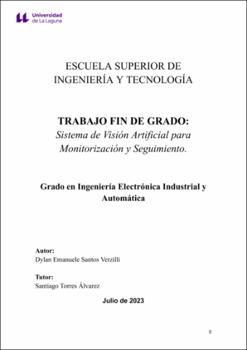Sistema de visión artificial para monitorización y seguimiento
Date
2023Abstract
El presente trabajo tiene como objetivo principal el diseño de un sistema
de vigilancia para monitorización y seguimiento de una zona delimitada, para lo
cual se hará uso de un algoritmo de inteligencia artificial especializado para la
detección de elementos pertenecientes a un conjunto de clases previamente
definidas en el mismo, el YOLOv5 de ultralytics. A final de conseguir la
detección esperada se debe llevar a cabo un proceso extenso de recolección y
selección de imágenes relevantes a la tarea a realizar, para poder entrenar el
algoritmo eficientemente.
Una vez entrenado el algoritmo, este deberá pasar por una serie de
pruebas que confirmen el buen desempeño que presenta a la hora de realizar
la detección de distintas situaciones posibles en las cuales puede encontrarse
trabajando dicho sistema. Para ello se utilizarán una serie de imágenes y
videos que cumplan con la variedad y complejidad de las situaciones
esperadas.
De la misma forma, la implementación del sistema cuenta con un placa
de circuito impreso especializada, la RaspBerry Pi 3 modelo B, para utilizar el
modelo entrenado sobre distinta información obtenida por medio de la captura y
grabación a través de un módulo de cámara conectado a esta.
Así mismo, serán discutidas aquellas líneas de mejora y posibles
aplicaciones del sistema diseñado, con el fin de proporcionar propuestas para
diseños futuros que mejoren el trabajo ejecutado por medio de la adición de
distintos elementos que complemente aquellos posibles aspectos que no hayan
sido implementados en el presente proyecto. The main objective of this work is the design of a surveillance system for
monitoring and tracking of a delimited area, for which use will be made of a
specialized artificial intelligence algorithm for the detection of elements
belonging to a set of classes previously defined in it, the YOLOv5 of ultralytics.
In order to achieve the expected detection, an extensive process of recollection
and selection of images relevant to the task to be performed must be carried
out, in order to train the algorithm efficiently.
Once the algorithm has been trained, it must undergo a series of tests to
confirm its good performance in detecting different possible situations in which
the system may be working. In order to achieve the expected detection, an
extensive process of collection and selection of images relevant to the task to
be performed must be carried out, in order to train the algorithm efficiently.
Similarly, the system implementation relies on a specialized printed
circuit board, the RaspBerry Pi 3 model B, to use the model trained on different
information obtained by capturing and recording through a camera module
connected to it.
Likewise, those lines of improvement and possible applications of the
designed system will be discussed, in order to provide proposals for future
designs that improve the executed work by adding different elements that
complement those possible aspects that have not been implemented in the
present project.





